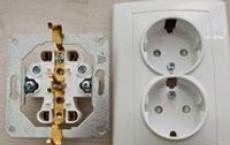Heating private house wall gas boiler circuit. Schemes of heating a private house. Two-storey large house
The most economical resource for heating today is natural gas. In addition, it is the most accessible. That's why the best option The device heating system in a private house is a gas heating private house. Even if the supply of energy is impossible, then there are alternatives (gas cylinders, gasholder).
Gas is the most popular resource for heating
And if there is a gas main in the area, the device of gas heating of a private house is simplified to a large extent. There are several optimal schemes for heating private houses with gas. One of the perfect options for permanent use in a private home is a gas boiler.
How to choose a gas boiler
Gas boilers differ depending on different indicators. By power they can be: low power (up to 65 kW), medium (up to 1700 kW) and large (up to 15,000 kW). Small and medium power are great for heating a residential private house. A large capacity of boilers is used usually at industrial facilities.
By functionality gas boilers can be single-circuit and two-circuit.
Single-circuit boilers serve only for applications in heating systems. Two-circuit boilers are also designed to heat water in CO and the needs of residents. Two-circuit boilers can be flow type. Such boilers are only used when the amount of hot water consumed is insignificant. Two-circuit boilers with built-in boiler provide full heating in a private house with gas and supply hot water. There are also boilers to maintain the temperature of the water in the pools, etc. (in this case these are specialized solutions).
 Double-circuit gas boiler scheme
Double-circuit gas boiler scheme Burners in gas boilers can be atmospheric and ventilating. Atmospheric burners are the most common option for heating private houses. Ventilating burners, as a rule, are used in industrial facilities.
By the type of traction, boilers can be supplied with natural draft (there must be a chimney here) and with a forced one (the exhaust gases are produced by means of a fan).
Depending on the method of installation, boilers that use the gas heating system of a private house are floor and wall mounted. Floor boilers have higher power, their sizes are higher. Also they are more durable and their cost is somewhat higher. Wall mounted gas boilers are relatively inexpensive devices, they are compact and have less power. Also wall-mounted boilers are less durable.
Water gas system for heating a private house
The most common heating system is water: the role of the heat carrier is played by water, which circulates through the closed loop of the pipeline. In the boiler, water is heated, then transfers heat through pipes and radiators (batteries) of heating.
Such system of gas heating of a private house has several advantages:
- water is an effective coolant;
- the circulation system is closed, so after initial filling, the volume of water should not change;
- water gas heating of the private house video, which can be seen below, will show that such a system can be arranged independently;
- in such a system it is easy to create a circuit that ensures a uniform supply of heat to each room.
Among the shortcomings of water gas system heating:
- heating radiators must be kept clean at all times, as dust efficiency will lower the efficiency of heating the premises;
- in comparison with air heating, water after the inclusion will not be able to provide the same rapid heating of air;
- elements that enter the water heating system can often crack, corrode, etc. This can not only worsen the microclimate in the house, but also cause damage to the interior of the premises;
- to the quality of the heat carrier - special requirements: the amount of salts must be minimized in water;
- heating can not simply be turned off and turned off in winter, when it's very cold outside, as this can lead to freezing of water, which will increase in volume and break pipes. Therefore, gas heating of private houses of this type is not suitable for dachas, where the owners are not often, especially in the winter.
Heating schemes for a private house
Depending on the fact that the coolant circulates inside the closed circuit, there is CO with a natural and forced circulation. In the first case, circulation occurs due to the difference in density of cold and hot water, and in the second case - the pump operates. If you want to make the heating system of a private house on your own, then you need to make a careful calculation of the optimal CO scheme.
Heating distribution is an important element in the system. It can be of two types:
- single-tube. In private houses it is not often used, because with such a wiring the temperature in the radiators is different. This option is suitable for houses that are small and have few rooms;
- two-pipe. This option is quite material-intensive. But to regulate the temperature in individual rooms the system is suitable.
One-pipe scheme of gas heating of a private house has one significant drawback - the bottom radiators are heated less, because they are already getting a little chilled water. And if you have a two-storey a private house, then on different floors of the room will also warm up unevenly. If you want to equip gas heating with your own hands, then this scheme will be much easier.

In addition, few materials are spent when laying a pipeline. The problem of uneven heating of radiators is solved by installing a jumper, increasing the number of sections. And for circulation of the coolant to occur faster, a circulating pump is used.
Note that the circuit with natural circulation will be suitable in the event that it is possible to install the boiler below the level of the location of the radiators. Also for the normal passage of the circulation process, a natural slope of the inlet and return pipelines is needed.
As for the artificial circulation, here the use of the pump is necessary. Such schemes are fairly simple to install, but they have several drawbacks. These include the same uneven heating, as well as the appearance of air congestion and dependence on electrical supply.
Very often you can find such an option as the Leningrad distribution of the heating system (Leningrad). The meaning of this system is that water circulates in the pipe closed on the boiler. It connects heating equipment (radiators), through which the coolant will go in parallel to the supply circuit. The system is quite effective for a private home.
The following scheme is two-tube. In this case, the radiators will be warmed evenly, but the costs of laying the pipes will be higher. The heating of individual heating radiators can be regulated by means of special shut-off valves.
Two-pipe system with natural circulation and lower wiring It is good if the boiler is located in the basement.
Stages of arrangement of gas heating in a private house
Gasification of a private home is an important and responsible process. The equipment for gas heating includes several stages:
- Preparation and approval of design and licensing documents. The project of gas heating of a private house should be created by specialists, since this is an important element on which further development depends.
- Purchase necessary equipment and materials.
- Cutting the house system into a street gas pipeline.
- Wiring gas networks inside the house, arrangement of a special room for a gas boiler.
- Installation of gas equipment.
- Filling the heating system with a heat carrier.
- Trial run. It is better to eat it with working and increased pressure.
- Acceptance of the finished system.
The schemes of the gas heating system must be thought through to the smallest detail, so the projects must be made by professionals.
 One example of a professional heating plan
One example of a professional heating plan When choosing equipment for gas heating, remember that the main indicator is the area of the heated room. It depends on the amount of equipment, the number of radiators, pipe meters, fittings, valves and valves, plugs.
In the process of selecting the method of laying the heating pipes and their installation, remember that the lines of cold and hot dilution must be carried out with a slight inclination directly towards the current of the hot water.
Experts recommend putting cranes on each battery. Thanks to this, it will be possible to control the supply of hot water to a separate room in a private house. If you use an expansion tank from 20 to 30 liters, it should be installed at a height of 3 meters above the boiler.
Conclusion
Gas heating residential private house - this is the most efficient and affordable option, if the area of your house is a highway. The fuel in this case is consumed economically, the gas equipment is simply in operation, and it is possible to equip such a system independently.
Add a comment
Choosing a dual-circuit boiler for the house, the consumer should understand that this unit is significantly different from a single-circuit one. First, the design. Secondly, by the presence of an additional circuit, which provides the house with hot water for domestic needs. Thirdly, the scheme of tying the gas double-circuit boiler.
The main differences between the two options
Tying the gas boiler
If we compare these two units, it turns out that a single-circuit one can also be used to heat water for domestic use. But in this case a separately standing tank - a boiler with a heat exchanger located in it - is connected to the boiler. Hot water for heating passes through this heat exchanger, leaving part of its heat and thereby heating the water.
In the case of a dual-circuit boiler, everything is completely different. Water for domestic needs is heated in the combustion chamber, passing through the second circuit. There are no boilers and other appliances, so heating is done directly without intermediaries. The only point to pay attention to is constructive feature unit and a technological approach to heating water in two circuits. If water starts to be used for domestic needs, it turns off automatically, and the heat carrier in it temporarily does not heat up.
How can this affect the heating system of the private house and the indoor temperature? If the house is equipped with high-quality thermal insulation, then the question of how the boiler works and how the mode is set does not matter. Periodic disconnection of the heating system will not affect the temperature inside the house, so there is nothing to be afraid of. For example, the fact that for a couple of hours of switching off the temperature inside the house will drop by a maximum of 2-3 degrees. And such a shutdown due to the selection of hot water is very rare.

Scheme of piping of a boiler with a pump
If the house has insufficient thermal insulation, or the building has very large rooms, then the question of the inertia of heat reduction must be addressed in other ways. For example, install more radiators or increase the number of sections. For this it is necessary to select radiators from a material with reduced inertia. Cast iron batteries slowly heated, but also slowly cool. So for such houses it is the best choice. We add that it is possible to reduce the degree of coolant cooling by increasing its volume. Again we return to the radiators and their number, and also take into account the diameter of the piping piping, namely, increase this figure.
And the last. If for some reason the amount of hot water consumed exceeds certain norms by the time indices, it is necessary to revise the option with the purchase of a two-circuit gas boiler. Even optimal scheme strapping here will not help, because such heating can not provide heat to the house without a long heating of the coolant.
Important! Use a dual-circuit boiler in a system with a natural circulation of the coolant is undesirable. The fact is that a decrease in the temperature in the system with the second circuit switched on not only causes a decrease in the temperature in the premises, but also is fraught with difficulties in collecting heat when the first circuit is switched on. Several such trips, and you can forget about a comfortable temperature - it will be distributed unevenly across radiators.
Although such a situation is possible only if the house is installed boiler, made by own hands. Ready-made units go on sale with already built-in circulation pumps. But to consider the scheme of tying, where natural circulation will be used, is still necessary. After all, it's no secret that power cuts in suburban townships are a common thing. With multi-storey houses there can be problems, but there is not one-story houses. So the owners of these houses are better to install bypasses, cutting off the contour, where the pump is built.
Strapping schemes
In fact, the circuit diagram of a single-circuit boiler does not differ from that of a two-circuit boiler. Yes, this is not necessary. It basically takes into account which boiler will be used - wall or floor. Sometimes the place of installation of the device and its power may affect the tube interchange. But if you correctly calculate and correctly plan the location of the circuits, it will no longer matter, for the wall-mounted boiler is wiring or for the floor.
Let's consider several options related to the size and floor of the house.
One-storey house in a small square
The ideal version of the strapping is the so-called Leningrad bench. This is a single-circuit circuit in the form of a ring, through which radiators are installed. That is, the feed pipe is also a return flow. In the center there is a double-circuit boiler.
What are its advantages?
- Slight consumption of materials.
- Simplicity of the scheme.
- A small coolant flow.

Single-pipe system
Usually such a circuit is used in small houses, where not a lot of people live. And this is a small expense of hot water. Already a plus. But in order to avoid problems, it is better to increase the volume of the coolant by making the system inert. Therefore, it is recommended that larger diameter pipes be used for heating purposes. For example, if you want to install a pipe 40 mm, then you should take 50 mm.
Now, as for the pipe, which removes the coolant from the boiler. Do not mount it horizontally right away. It is necessary to take into account the vertical segment, which experts call the overclock collector. Remember about power outages! Therefore, you need to create a system that can work under a scheme with natural circulation. But after a vertical riser, you can conduct the pipeline horizontally with a slight slope.
And the last thing is the installation of the expansion tank. This must be done necessarily. And the volume of the tank should be 10% of the volume of the coolant.
Two-storey large house

Wiring plan for Baxi double-circuit boiler
It should not be tricky, because the optimal solution is a two-pipe scheme with top filling. That is, from the double-circuit gas boiler, the riser, supplying the heat carrier, rises upward. In the attic, it is divided into contours, which are lowered into the rooms by risers. It is to them that the radiators are connected, but they do not open the riser itself, which is very important. All the risers, having passed two floors, are closed on the reverse circuit, which supplies the coolant to the boiler.
In the case of a two-story house, another scheme can be proposed, where two boilers will be used - one on each floor. This simplifies the circuit by dividing it into two separate circuits. We add that this scheme of binding is considered economical in the sense that it is possible to lower the temperature inside the system if one floor - usually the second one - is used by household members seldom.
The universal scheme
If you make a small initial expenditure, then there can be any. That is, it will not affect the efficiency of heating operation so much. To do this, you will have to purchase and install a conventional water-heating boiler with a volume of 200-300 liters. It will play the role of a battery of thermal energy and thereby increase the inertia of the system.
Install such a tank anywhere, connecting it to the circuit. It can be a basement, a place next to the boiler, on the street and so on. Here the convenience of installation and maintenance is important. The tank must be well insulated.
Conclusion on the topic
As you can see, the scheme for connecting a gas dual-circuit boiler is not limited to one option. And even those described are not the ultimate truth. There are many approaches to creating an economically justified heating system. But in the case of a dual-circuit boiler it is necessary to take into account all the nuances mentioned above.
Heating systems using gas as a fuel have excellent efficiency and reliability. Generators of thermal energy in them have high efficiency and are safe in operation. There are several ways to organize gas heating for a private home. There are solutions both budgetary in performance, and more expensive with maximum economy and stability in operation.
Without combustible fuel, there will be zero sense for any variant of the in-house heating system in standalone version. Gas is the first thing to think about when planning in a country house gas heating.
Not all settlements in Russia are gasified. However, "blue fuel" can be obtained not only from a tube or a cylinder with liquefied fuel, but also from a gas holder.
In the absence of the village gas main it is possible to use the option with an autonomous supply of fuel from a gas holder for storing gas in a liquefied state
Natural gas, consisting mainly of methane, is supplied to private homes through pipes. Its liquefied analogue is a propane-butane mixture, which for transportation and storage is pumped into containers. The pressure in such cylinders and gas tanks is about 15-18 atmospheres.
When heating in a private house with the help of balloon tanks of 50 liters last winter will have to change every 2-3 days. If for country cottage the autonomous gas supply is chosen, then it is best to prefer a gas tank that can be up to 20 cubic meters in volume.
The choice of capacity per cubic capacity depends on the level of consumption of liquefied petroleum gases (LPG). Here it is necessary to take into account not only a hot water boiler, but also a fireplace and a gas stove, if they are used in the house. For a cottage of 150 sq.m. it is recommended to install a gas-holder in volume in 2000-3000 liters. And for a country house of 300 sq.m. an option for 8000-9000 liters is required.

The main disadvantage of gasholder - it can be installed only in a large area, the capacity according to the requirements of SNiPs should be at least 10 m from the house
At the cost of connection, the gas pipeline is in most cases more advantageous than the reservoir in the ground. But only when locality already gasified. Possible situations where the installation of gasholder will cost less than connecting to the main pipeline. Everything depends on the specific conditions of connection in the region and the remoteness of the village from the big gas main.
When using a gas holder, you do not have to worry about the pressure in the pipe. It is extremely simple to operate. You just need to regularly call specialists to check it for safety, and do not forget to make a refueling. It takes no more than three days to install the entire system.
If an autonomous gasification option is chosen, the gas boiler should purchase one that is designed for LPG operation. On sale there are models designed to function exclusively on the main natural gas. But most gas heat generators are adapted for burning both types of this fuel. It will only be necessary to change the jets, and also to reconfigure for a different valve mode and electronics.
Selecting a heating gas boiler
Modern heat-generating equipment for gas has a variety of automation and is able to operate in several modes. It can be floor and wall. The second option is more compact, but has power limitations. If the model is chosen for a large private house, you will have to purchase a powerful unit in the floor version.

Gas boilers are subdivided according to the type of execution, type of ignition, energy efficiency, number of circuits and combustion method (+)
The principle of functioning of the gas boiler is extremely simple - the combustible is ignited in the burner by means of piezoelements or electronic ignition, then as a result of fuel burn-up thermal energy is generated, which is transferred to the water by means of a heat exchanger. The latter is already used as a coolant in the heating system or is consumed in the DHW.
By the efficiency of traditional convection gas boilers lose condensation. The performance of the former does not exceed 90% of the energy consumption. Manufacturers of the second guarantee an efficiency of 100%, in some models promised 105 and even 110% (+)
The heat exchanger in the gas boiler can be made:
- from steel (stainless steel);
- copper;
- cast iron.
The most common variants of steel. This metal is cheap and plastic, due to which cracks from constant heating / cooling in it appear less often. But steel elements with constant interaction with water of the gas heating system, equipped in a country house, quickly begin to corrode.

Cast-iron heat exchanger is the most durable, steel is cheaper, and copper is most effective in capturing heat transfer to water
Cast iron is less prone to corrosion, but it is quite heavy. Most models of boilers with cast-iron heat exchangers are outdoor. On the wall, such heavy and oversized equipment is difficult to mount. If you need a compact and extremely light heating unit, the best option is with a copper coil. However, it is the most expensive among analogues from other metals.

To supply the cottage with heat and hot water, you can choose a scheme with two single-circuit boilers or an option with one dual-circuit installation
The number of circuits in the water-heating boiler on the gas depends on the scheme of the strapping and the principle of its use. One heat exchanger is initially intended for the organization of a gas heating system in a private house. For DHW it is necessary to install one more boiler or to immediately select a two-circuit model.
Heat hot water for domestic needs is best in a storage tank. Streaming models are less economical. The gas they spend on heating will be more.
Represent a fully equipped miniature boiler house. They have their own circulating pump, expansion tank and safety group. Most types of wall-mounted equipment serves two circuits (+)
Which combustion chamber is better
To ensure that the gas in the furnace of the boiler burns, it needs a constant supply of oxygen. It is taken directly from the boiler room or drawn from the street. The first option implies a natural influx of air, and the second - forced by the fan.
Gas boilers are equipped with two types of combustion chambers:
- Closed - oxygen feed is produced through the gap between paired pipes of different diameters. Combustion products are diverted through the internal channel.
- Open - air in the furnace comes from a room with a heating unit through check valve. The combustion products are drawn out in a circular fashion through a smoke channel.
The first option is independent of the area of the room. Suitable for rooms of any size. The coaxial view of the chimney from the unit with a closed firebox can be displayed through a wall or an upper ceiling with a roof.
In the second case, it is necessary to install a high-level chimney in 5-6 meters, otherwise the drafts for sucking in the combustion chamber of the necessary volumes of oxygen will be insufficient. But gas boilers with an atmospheric burner do not need to be connected to the mains. There is no fan in them, everything happens naturally without forced circulation.
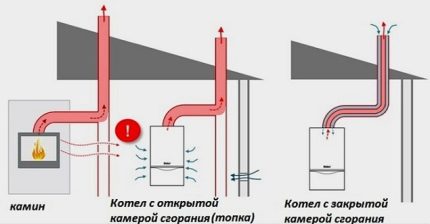
Boilers with closed chambers and forced air injection in comparison with open air boilers have higher efficiency, but they require constant power supply for operation
Water heaters with gas with an open firebox are recommended to be placed in special rooms with good ventilation. If you mount them in living rooms, they will greatly reduce the amount of oxygen in these. Without a forced ventilation system, this will not be enough. And this is additional spending on the installation and subsequent operation of equipment for air ventilation.
Characteristics of condensation models
In conventional gas boilers, the water vapor generated by the combustion of gas flies into the chimney. In the process of combustion, it is formed a little, but it nevertheless carries in itself a sufficiently significant volume of thermal energy. In order not to waste this heat, condensing boilers were developed.

The flue gases in the condensing boiler, before leaving the chimney, pass through a secondary heat exchanger where the cold water supplied to the unit is heated slightly
The principle of operation of these units is based on the fact that when cooling the steam of waste gases, it releases heat to the water from the return of the heating system. The temperature of the coolant increases slightly, but as an additional source of heat energy, the recuperator is perfectly suitable.
The condensed water from the condensing boiler is discharged through a special branch pipe into the sewage system or a separate container. Here one should clearly understand one nuance - the condensate formed is actually a weakly concentrated acid. And at an hour it can leak to 4-6 liters.
If this liquid is poured into the septic tank, all microbes living in it will be destroyed. If there is a cleaning station in a country house, drain condensate from the boiler into the sewer system from the boiler. With the design of the chimney all is easier, it is enough to take one that is designed for boilers with a closed chamber.
Gas fireplace - the original solution
At the cost of equipment, gas fireplaces are comparable to electric or wood analogues. But gas fuel is much cheaper. And unlike firewood, gas heating with the help of a fireplace in a country house assumes no problems with ash. Plus, you do not have to constantly monitor the work of the furnace and take care of the logs of logs.
Fireplaces that process gas in thermal energy, are used in heating systems, because Do not have the devices necessary to maintain two circuits
By type of installation, fireplaces on gas are:
- walled;
- island;
- built-in.
According to the general design and internal filling (burners, automation, combustion chambers), they completely repeat gas boilers. In both cases, the technology for connecting to networks is identical. Differences exist only in the principle of heating the premises.
By the principle of connecting and organizing a heating system, gas fireplaces are similar to floor heating boilers (+)
The hot water boiler is originally designed for heating water, and a regular fireplace - for convection of air from the body and the front screen, followed by burning of fuel.
Schemes of water heating in a private house
For heating cottages are equipped with heating systems with water as a coolant, consisting of:
- water boiler (single-circuit or dual-circuit);
- pipelines and fittings (metal or polypropylene);
- bypass, which allows to disconnect individual heaters from the network;
- batteries (cast iron, aluminum, steel and bimetallic);
- expansion tank.
Gas heating units are equipped with a specific safety system, including a solenoid valve and thermocouple. The devices are interconnected by wires. If the heating system is functioning normally, the junction of the thermocouple is heated by a pilot. At this time, the current flows freely through the coil of the solenoid valve, which ensures the open position of the valve. When the thermocouple cools, the gas is blocked by a solenoid valve.
According to the scheme of connecting the batteries they are single-tube and two-tube. In the first case, water is supplied and taken away from the radiator by means of a single pipe. In the second, the heater is connected to two separate pipelines (supply and return).

Heating pipes to batteries can be connected on the bottom, top, side and diagonal scheme
Heating circuits by the principle of movement of water in the pipes come with forced and natural circulation. With the device of the second variant, the coolant circulates in the system due to convection and gravitation. A compulsory scheme involves the installation circulating pump.
To ensure the normal operation of the system with two or more circuits connected to the collector, it provides for the installation of a hydro-gun. The hydraulic pointer eliminates pressure drops and the likelihood of a water hammer.
The expansion tank can be open and closed (divided in two by a sealed membrane). For gravity heating systems, there will be an open option. Closed tank For circuits with forced circulation.

When using an open expansion tank, the water is saturated with air so that it does not become a problem, the system should be supplemented with a circuit for removing it
For small cottages there will be enough natural movement of water. However, if the residential building has two or three floors, then a pump can not be dispensed with. The length of the circulation circuit in the first scheme is limited to 30 meters. For a greater distance, the boiler can not "press" water.
When natural circulation The coolant in the scheme of gas heating of a private house is absent. If the boiler is chosen to be non-volatile, the entire heating system is independent of the power supply. It simply does not have electricity consuming elements.
On the one hand, it is more stable in operation, but on the other - the quality of heating in it is lower (to the farthest from the water heater radiators the water comes down strongly cooled). Especially the latter concerns pipelines and batteries made of steel or cast iron. These materials have high hydraulic resistance, which reduces the heat carrier current.

In addition to the use of standard radiators in a country house, it is possible to organize gas heating with the help of a "warm floor" (+)
Possible and the option of organizing a combined heating system. In it, the circulation pump is connected to the main through the bypass. If you need to quickly warm up the air in the rooms, it turns on to accelerate the circulation of water. In other cases, it is cut off from the main pipe by stopcocks, while the system continues to function in a natural (gravitational) mode.
What you need to arrange gas heating
Gasification and gas-based heating in a private house are carried out in several stages:
- Preparation and subsequent approval in the supervisory bodies of the project of gas heating.
- Acquisition of consumables, a boiler and other equipment.
- Connecting the house to the village gas networks.
- Installation of gas equipment and piping systems with batteries.
- Filling of pipes with coolant.
- Verification of operability by trial run.
Independently prepare for your a country house the project of gas heating with all schemes and calculations without a diploma of heat engineering is impossible. In addition, the documentation has yet to be coordinated with the gas specialists. It is best to entrust all these procedures to the employees of the relevant design and installation organization.
The scheme of arrangement in the private house of gas heating should be calculated to the smallest detail. If the boiler is too powerful, it will burn excess fuel. And if the capacity is insufficient, the unit will have to work at the limit of possibilities, as a result of which it will fail before the deadline.
Video reviews for those wishing to heat the house with gas
Nuances of organization of gas heating of the cottage:
Principles of coolant circulation in the heating system of a private house:
Self-assembly of various heating systems for country cottages:
Competently prepare for a private house calculations and schemes for organizing gas heating in the state only experienced heat engineer. Compilation project documentation and its coordination is best entrusted to professionals. But the further installation of the heating system can be done independently. Only the skills of installation work will be required here, as well as the strict adherence to instructions and the project.
The piping of the heating boiler is a system of pipelines and equipment designed to provide coolant to the radiators. Simply put, it's everything, except for batteries. Do not be afraid of the abundance of pipes, devices and technological stages. After reading the article you will be able to work this job. And if the heating boiler itself is arranged, then it will serve longer, and it will take less money.
The first step is the selection of a heating boiler, the performance of which must be determined beforehand.
The calculation of the required capacity of the heating unit is affected by many factors, such as:
- the volume of the building;
- the number of windows and the total area of the glazing;
- number and area of doorways;
- thermal conductivity of materials used in the construction of walls;
- degree of insulation of load-bearing structures;
- average annual temperature in the construction region;
- the location of the building, i. on which side of the world comes the main, traditionally the most glazed, facade.
However, there is an average indicator that, without in-depth calculations, allows you to determine the required performance. For the central band for the starting point (but not the guide to action!), You can take 1 kW per 10 m² of heated area. To the calculated capacity of the boiler, it is necessary to add a stock of at least 20%.
Heat for heating buildings is obtained by processing fuel in boilers heating the coolant
Types of heating boilers
Conditionally the heating boilers can be divided into standalone and manual loading.
Autonomous boilers, depending on the fuel used, are:
- solid fuel;
- electric;
- gas;
- oil-fired.
The order in the list determines the cost of heating, depending on the type of fuel: gas boilers will be the cheapest in operation. Boilers are equipped with automatic control of the set temperature of the coolant. All the working life can work all the year round. There are wall-mounted and floor-standing.
Image Gallery








Boilers for manual loading include boilers for solid fuels. As fuel used wood, peat, coal. Require the participation of a person to load fuel. Maintaining the right temperature of the coolant is also a part of the person's responsibility. Execution of boilers - outdoor. Equipped with a minimum set of automatics. Heating boilers they are one- and two-contour ones. A double-circuit boiler is connected with a water pipe, which is built to heat hot water.

Heating systems with a heating boiler should provide the necessary temperature in the treated premises. The strapping scheme should be oriented to the uniformity of heat supply to all devices
Independent heating boilers and the principle of operation
In most modern gas boilers for autonomous heating, the temperature of the coolant is maintained automatically. Inside the unit there is a heat exchanger, heated by a burner on liquid or gaseous fuel. The boiler's thermal sensor constantly monitors the temperature of the coolant.
As soon as the temperature has reached the preset level, the burner goes out and the heating stops. If the coolant temperature falls below the set limit, the burner is ignited again. Such ignition-damping cycles can occur quite often, there is nothing wrong with that.

If you plan to install a heating system with high capacity, then there is a possibility of overheating of the coolant. In such schemes of strapping, it is necessary to provide a thermal accumulator
The vast majority of installed heating boilers heat the coolant by processing gas or liquid fuels. This is facilitated by ubiquitous gasification and high reliability of boilers.

In the schemes of tying with solid fuel boilers, there is no provision for the regulation of the heat supply, the burning process can not be controlled. If the combustion stops, the circulation pump stops (click to enlarge)
Pros of gas and liquid fuel boilers:
- ease of maintenance;
- a lot of security systems, often duplicating;
- part of the equipment is included (circulation pump, manometer).
Unconditional dignity is a high efficiency, which on average is 98%.

For heating systems, water can circulate at a temperature of no more than 105 ° C, steam heated to 130 ° C or air up to 60 ° C. When the operating parameters are exceeded, the safety group
There are also disadvantages:
- in the absence of electricity, the whole system stops, a threat of defrosting is created;
- high price;
- the circulation pump works around the clock;
- can only be used in closed systemsoh.
When installing an autonomous boiler, you need to consider the constant costs of electricity. The circulation pump runs continuously, regardless of whether the coolant is heated or not.
Solid fuel boilers for manual loading
AT solid fuel boilers loading and ignition of fuel occurs manually. The combustion intensity can be adjusted in a limited range. The operating time is determined by the burning time of the fuel of one load.
Solid-fuel boilers are the most versatile solution, their advantages include:
- independence from electricity;
- can be used in closed and open systems;
- low price.
Units of this type work on the most affordable form of fuel.
There are significant disadvantages:
- as a rule, are delivered with a minimum set of equipment;
- require constant monitoring by a person;
- have a low efficiency.
For the solution of traditional "winter" problems one of the options may be the use in one heating circuit of two boilers of different types. In the normal mode, an autonomous boiler operates, and in the event of an accident on a gas or electric line, a solid fuel heating unit is manually started.
Such a scheme will not allow the heating system to sub-cool and freeze. The second option, maybe the use of a special, non-freezing coolant - antifreeze.
From the type of heating unit depends largely on the choice of scheme for tying the boiler heating.
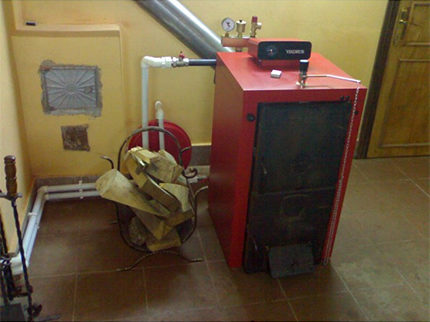
When installing a solid fuel boiler it is very important to observe all the distances from the walls
Types and schemes of heating
The purpose of the heating system is to transfer heat from the boiler to the radiators. The energy is transferred through the circulation of the coolant.
The heating circuit can be realized in the following ways:
- open one-pipe circuit;
- closed one-pipe circuit;
- closed two-pipe circuit.
Two-pipe closed heating circuit is the most progressive, has the highest efficiency. However, it is the most expensive and difficult to implement.
When heated, the heating system increases the volume of the coolant, the excess coolant is collected in the expansion tank. During cooling, the reverse process occurs: the heat carrier decreases in volume, the heating system draws the coolant from the expansion tank. By the way the organization of the expansion tank, the system is divided into open and closed.
Open circuit of the heating system
When open system the expansion tank is open, freely communicates with the atmosphere. The general arrangement is as follows: the heating boiler is located at the lowest point, the expansion tank is in the uppermost, with respect to the radiator. The greater the difference in the height of the expansion tank and the uppermost radiator, the better.
Image Gallery


![]()

Circulation of the coolant in an open single-tube system occurs naturally, heated water moves or its mixture with antifreeze due to gravity. Cooling the coolant becomes heavier, because of which it gradually descends to the lower level of the system. Heavy substance is pushing out a lighter, hot coolant. So they constantly alternate, i.e. the coolant moves along the ring of the heating system.

The boiler's piping scheme in the open heating system does not require the mandatory installation of control devices. In case of overheating, it will spontaneously get rid of the excess heat carrier (click to enlarge)
Such an organization of the heating system has its advantages:
- the simplest scheme;
- there is no need for electricity, because the coolant moves by gravity;
- weak sensitivity to emergency pressure increase (for example, when boiling).
The device of the system with natural movement of the coolant will need the least amount of money, because it makes no sense to equip it with automation, bypass valves, a circulation pump.
Unfortunately, there are significant drawbacks:
- constant contact of the coolant with air, leads to gas contamination;
- the possibility of cooling the coolant in frost;
- relatively slow circulation of the coolant;
- it is impossible to achieve the same temperature of the radiators;
- a large volume of coolant is required.
With an open system, the constant contact of the coolant with atmospheric oxygen leads to increased corrosion of pipelines and radiators. The formation of various contaminants reduces the efficiency of the heating system in general.
With aluminum and bimetal radiators, this system works poorly.
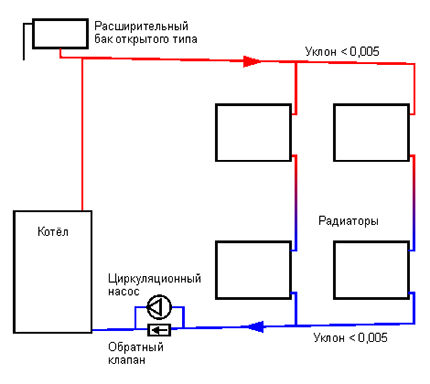
With a flow system with natural circulation, it is important to observe slopes. The expansion tank is at the highest point of the system
An open single-pipe heating system is the easiest to implement and the least efficient. It is used with manual loading boilers. It is used, mainly, for heating small private buildings in one two floors.
Closed circuit heating system
With the heating system closed, the expansion tank is made in the form of a steel container inside which is a rubber pear or membrane under air pressure. With the expansion of the coolant, the pear shrinks and releases additional volume.
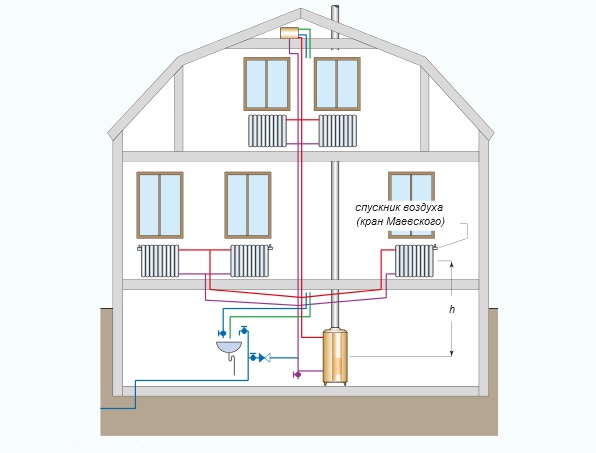
In a closed heating system, the excess pressure when the coolant is overheated is removed using a Mayevsky crane
Compulsory circulation of the coolant makes it possible to heat up all radiators faster and more evenly. In this case, the coolant by means of special air vent valves once again gets rid of all the gases in it. Pipelines remain clean and corrosion does not occur.
Image Gallery
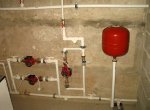

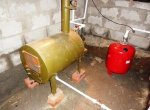

The layout of the boiler and the expansion tank can be any: the boiler can be located in the basement or on the first floor. Expansion tank, as a rule, is installed next to the boiler.
The advantages of a closed system:
- clean heat carrier;
- guaranteed circulation
- free arrangement of equipment;
- the minimum amount of coolant;
- small diameter of pipelines.
Disadvantages of a closed system:
- constant overpressure;
- increased cost.
A closed, single-pipe heating system remains, quite inexpensive, allowing the use of all types of boilers.

With the heating system closed, there is freedom of installation. The expansion tank can be next to the boiler
Single-pipe heating system
According to the way the coolant moves along the pipeline scheme and the devices included in it, the heating systems are divided into one- and two-pipe systems.
With a single-pipe heating system, the main line of a large diameter - the feed - extends from the boiler. She acts as a transporter of the hot coolant and its collector in a cooled form. The radiators are connected in series to the pipeline by two thinner pipes. One of them takes the coolant, the other lets out.
The heat carrier alternately passes all the batteries, parting along the way with a part of the thermal energy.
- Flowing. In the flow diagram there is no feeder riser as a structural element. The radiators of the upper floor are connected to the analogues on the lower floor. In this scheme, you can not use adjusting cranes to not block the access of the coolant to the following devices.
- With bypasses. According to this variant, the radiators are connected by risers, but are separated from the contour by the closing links. The coolant comes from the supply pipe. Distributed by portions of all devices, which comes in almost at the same time, so that it cools less.
The heating circuit with bypass allows you to adjust the temperature and repair the failed device without disconnecting the entire system. In this respect, the flow variant loses the same way as the coolant cooling rate. But a flowing variety is easier to implement.

In single-pipe systems with forced circulation, the heated coolant rises along the main riser and is distributed over the series-connected batteries
If a single-pipe circuit is used in a heating circuit with a natural coolant circulation, there are no return risers at all, and only the upper wiring is used to connect the devices.
With a two-pipe heating system, one pipeline supplies a hot heat carrier heated by the boiler. The second - takes and takes it in a cooled form back to the heating unit. The receiving pipe is called the feed, the collecting pipe is called the return flow. The heating radiators are connected in parallel.
The coolant in the coldest radiator has the lowest temperature, accordingly it is stronger than the rest of the pressure. The circulation of the heat carrier is the more intense, the greater the difference in temperature between the supply and the return connection. As a result, the cooler will warm up more quickly. Thus, the temperature in all devices connected to the same manifold is equalized.
Pluses for heating with two pipes:
- adjustment for the temperature parameters of one radiator does not affect the rest;
- hydrodynamic stability of the entire system;
- it is easy to connect devices for regulating the supply of hot water;
- all pipelines can be hidden in floors or walls;
- high speed and efficiency.
Two-pipe systems are available with top and bottom wiring, with dead-end and passing heat carrier transportation. There are with its natural movement and with forced circulation, stimulated by circulation pumping units.

Two-tube heating system more difficult and expensive than single-tube, but in terms of the creation of comfortable conditions significantly exceeds it (click to enlarge)
In circuits with natural circulation, the boiler is installed
Of the minuses, we can distinguish the following:
- double number of pipelines;
- relatively high price;
- need for the use of shut-off and control valves.
The two-pipe system, despite its complicated design, is the preferred solution, especially when used with autonomous boilers.
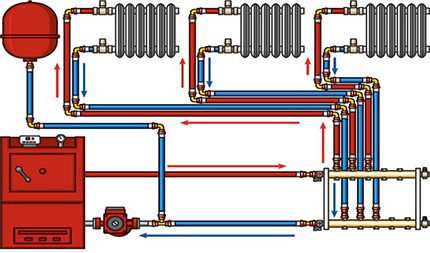
The heat carrier is disassembled from a pair of collectors
If you do not resort to complex heat engineering calculations, then you can take advantage of many years of experience in the construction in the middle lane. For the construction of the supply and collecting lines, it is recommended to use two-inch pipes (Ø 50mm) connected to the boilers. The sockets are made of pipes of the same size.
Batteries, depending on the number of sections, are connected to the supply and return of pipes by 1.5 "(by 25-35 sections), 1" (by 10-25 sections), 3/4 "(less than 10 sections).
When constructing an autonomous heating system with one or more boilers to achieve the greatest efficiency and comfortable microclimate, a two-pipe system is suitable. It can be used on any objects. Works with any type of radiators and any boiler. The selection of the heating scheme depends on the desired price-quality ratio and the purchased boiler.
Implementation of the heating system
Armed with the necessary knowledge of the principles and merits of each scheme of heating, you can make an order of actions:
- choice of the scheme of heating;
- selection of the heating boiler;
- purchase of necessary equipment;
- installation.
For an open, single-pipe heating system, it is sufficient to have a thermometer (in most cases, it comes with a boiler) and an expansion tank, usually homemade. For closed systems, the minimum necessary equipment is similar and discussed below.
Acquisition of necessary equipment
The mandatory list of equipment for closed heating systems includes:
- expansion tank;
- overpressure relief valve;
- circulation pump;
- automatic vent valve;
- in the case of a two-pipe system, collectors (another name is combs);
- pipes.
When purchasing a boiler for autonomous water supply, part of the equipment can not be purchased. The equipment offered for sale, as a rule, is already equipped with a circulation pump, safety valve, expansion tank, manometer.

Before choosing the necessary equipment, you should draw a chart in scale and draw up a list of required elements
Features of mounting of heating boilers
Heating boilers are produced in the floor and wall version. Depending on the version, they are installed.
In a row of wall-mounted boilers there are turbines. These are boilers that forcibly divert the exhaust gases and supply air to the combustion chamber. In such boilers, super efficient fuel processing takes place, which means that the exhaust gases have a low temperature. The gas outlet and the air supply are made by means of a special one. Pipe horizontally with a slight bias is displayed on the street. Slope is necessary to drain the condensate to the street, and not inside the boiler.
The choice of the scheme of the walling of the wall-mounted boiler can only be closed type, since all wall boilers are autonomous.
In all other boilers, including manual floor loaders, the exhaust gas is discharged into the vertical chimney. The part of the chimney that faces the street must be insulated to prevent condensation.
For a floor, solid fuel heating boiler, a solid base and a platform of non-combustible material (sheet of iron, ceramic tile). The scheme for tying the floor boiler of manual loading can be open and closed, one-pipe and two-pipe.
![]()
When installing a wall-mounted boiler with coaxial tube. The best place is the external wall of the boiler room, so the pipe length will be minimal
Selection and installation of expansion tank
Even if an expansion vessel is already installed in the heating boiler, it is strongly recommended to install an additional tank. The volume of the expansion tank is chosen based on the volume of the coolant. A good option The expansion tank will be mounted on a standard manifold, together with an automatic vent valve and a manometer.
Before installing the expansion tank, it must be pumped with air to the recommended pressure, usually 1.5-2.0 Atm. It is better to install the expansion vessel next to the boiler.
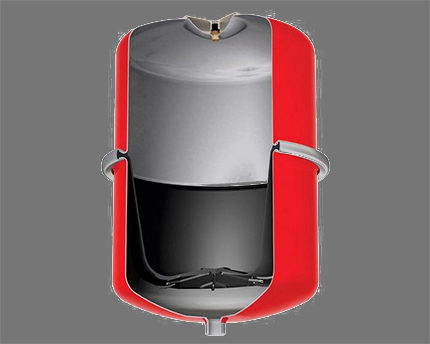
For reliable operation of the device, it is necessary to check air pressure at least once a year
Installing the circulation pump
The necessity of using an additional circulating pump, its parameters are determined by hydraulic engineering calculation. There are several general remarks.
The operation of the circulation pump is designed for a temperature of the order of 60 ° C. Therefore, it is advisable to mount the pump on the back of the pipe, with a cooler coolant. Also for safety reasons, if the coolant overheats to steam, when installing the pump on a straight pipe, the impeller of the pump will stop working, which will lead to even more overheating.
The direction of the coolant flow is clearly marked on the body of the circulation pump. The orientation of the circulation pump can be any, but the rotor should always remain in the horizontal plane.

It is permissible to mount the pump, so that the shaft rotates in the sliding sleeves. Otherwise, the pump will quickly fail
Automatic air vent valves
Even with the formation of air pockets, for the removal of gases, there will be enough one valve. Sooner or later the air will dissolve in the coolant through the valve. However, the rate of dissolution is small and this withdrawal can take up to several months.
The correct setting is only possible on a fully inflated system. In order not to wait several months, several automatic valves must be installed.
A good place to install automatic valves - on the combs and collectors.

The safety valve, pressure gauge, automatic air vent valve makes sense to be mounted together - in the safety block
Site Selection and Collector Installation
The purpose of the collector is distribution of the heat carrier by consumers. Consumers can act warm floors, heating radiators, coils in the bathrooms.
Structurally, the manifold is a section of a pipe with several outlets. The number of bends must correspond to the number of consumers. For a two-pipe system, the number of collectors is at least two. For each tap, the volume of the supplied coolant is regulated.
When organizing the heating of a two-story or more house, a pair of collectors is made for each floor. If there are warm floors, for them it is necessary to allocate a separate collector. There is a couple for each floor. Individual reservoirs are necessary for the following reasons:
- due to the difference in hydrodynamic resistance of pipelines between the nearest and the far radiators of heating;
- at various characteristics of consumers;
- for a reliable setup of the entire system.
Due to the different hydrodynamic resistance, it may be necessary to install an additional circulating pump in the boiler's piping circuit, for example, on a collector of warm floors. For ease of adjustment, collectors are mounted in one place, in a special cabinet.

The collector is an excellent place for mounting auxiliary equipment: pressure gauges, safety valves, flowmeters
Selection of pipe material for a single-pipe system
For single-pipe systems, the most common are steel pipes. A large choice of diameters and not high cost make this choice preferable.
When installing pipes, the slope should be at least 5 mm per running meter. Aesthetically inclined pipes look worse, but ensure reliable circulation of the coolant, even if the circulation pump is switched off.
Connection of heating radiators, in an open system, produces a pipe with a minimum diameter of 32 mm. The straight and return lines are made of pipes with a larger diameter, a minimum of 50 mm.

Steel pipes are a practical material, but are prone to corrosion and require painting. Polymer pipes have less hydraulic resistance, therefore smaller diameter can be used
Pipes for a two-pipe system
The two-pipe system does not require large diameters. The pipe material can be various: polypropylene, metal plastic, etc.
The main thing is that pipes can withstand pressure and temperature. Since the two-pipe system does not require natural circulation, the pipes are hidden in underground space or in walls. All pipes must be insulated to prevent heat loss.
Pipes connecting the collector have a diameter of 20-25 mm., Connect heating appliances 16-20 mm. respectively.

The use of modern materials and installation techniques does not require welding. All editing is done as in the designer
Each bending of the pipe adds hydrodynamic resistance, if possible it should be avoided. A big difference in the hydrodynamic resistance of the branches of one reservoir makes it difficult or impossible to regulate.
After mounting all components, pressurization with increased pressure is mandatory. The pressure should remain constant for at least 24 hours. If the heating system has successfully passed the tests, the piping of the heating boiler can be considered complete.
How to choose the most suitable heating unit:
Comparative analysis of heating system options:
At first glance, heating systems seem complicated. At the same time, the principles by which the heating system works are very simple. Correctly designed and executed system is able to work for years without any interference.



